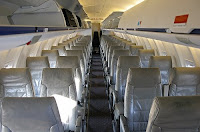 Airliners developed since the 1940s have had pressurized cabins (or more accurately, pressurized hulls including baggage holds) to enable them to carry passengers safely at high altitudes where low oxygen levels and air pressure would otherwise cause sickness or death. High altitude flight enabled airliners to fly above most weather systems that cause turbulent or dangerous flying conditions, and also to fly faster and further as there is less drag due to the lower air density. Pressurisation is applied using compressed air, in most cases bled from the engines, and is managed by a environmental control system which draws in clean air, and vents stale air out through a valve.
Airliners developed since the 1940s have had pressurized cabins (or more accurately, pressurized hulls including baggage holds) to enable them to carry passengers safely at high altitudes where low oxygen levels and air pressure would otherwise cause sickness or death. High altitude flight enabled airliners to fly above most weather systems that cause turbulent or dangerous flying conditions, and also to fly faster and further as there is less drag due to the lower air density. Pressurisation is applied using compressed air, in most cases bled from the engines, and is managed by a environmental control system which draws in clean air, and vents stale air out through a valve. Pressurization presents design and construction challenges to maintain the structural integrity and sealing of the cabin and hull and to prevent rapid decompression. Some of the consequences include small round windows, doors that open inwards and are larger than the door hole, and an emergency oxygen system.
To maintain a pressure in the cabin equivalent to an altitude close to sea level would, at a cruising altitude around 10,000 m (33,000 feet), create a pressure difference between inside the aircraft and outside the aircraft that would require greater hull strength and weight. Most people do not suffer ill effects up to an altitude of 1800–2500 m (6000–8000 feet), and maintaining cabin pressure at this equivalent altitude significantly reduces the pressure difference and therefore the required hull strength and weight. A side effect is that passengers experience some discomfort as the cabin pressure changes during ascent and descent to the majority of airports, which are at low altitudes.

